Sialolith Characterization by Scanning Electron Microscopy and X-ray Photoelectron Spectroscopy
Abstract
The objective of this study has been to characterize sialolith, a calcium phosphate deposit that develops in the human oral cavity, by high-resolution field emission scanning electron microscopy (SEM) and X-ray photoelectron spectroscopy (XPS). The morphological and chemical data obtained helped in the determination of their formation mechanism in salivary glands. Sialoliths in the submandibular salivary glands may arise secondary to sialodenitis, but not via a luminal organic nidus. We believe this is the first study that characterizes a sialolith by XPS. SCANNING 29: 206-210, 2007. © 2007 Wiley Periodicals, Inc.




